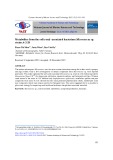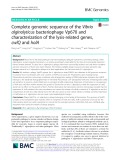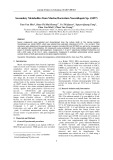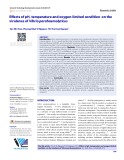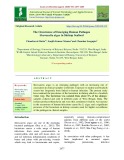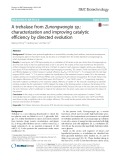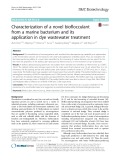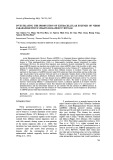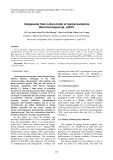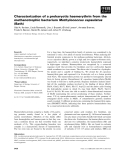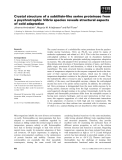
Marine bacterium
-
This study implicated the soft coral-associated Micrococcus sp. strain A-2-28 (following relative Micrococcus flavus LW4T) for large-scale cultivation, chemical analyses, and biological activities. Whereas crude extract of the strain A-2-28 inhibited only Staphylococcus epidermidis, metabolites profiles and pure compounds from strain A-2-28 showed that this strain produced phytohormone (IAA), metabolized some new compounds which were almost inactive for biological tests.
 8p
8p  dianmotminh02
dianmotminh02
 03-05-2024
03-05-2024
 4
4
 1
1
 Download
Download
-
Biocontrol of bacterial pathogens by bacteriophages (phages) represents a promising strategy. Vibrio alginolyticus, a gram-negative bacterium, is a notorious pathogen responsible for the loss of economically important farmed marine animals. To date, few V. alginolyticus phages have been successfully isolated, and only three complete genome sequences of them have been released. The limited available phage resources and poor genomic data hamper research on V. alginolyticus phages and their applications for the biocontrol of V. alginolyticus.
 11p
11p  vitzuyu2711
vitzuyu2711
 29-09-2021
29-09-2021
 6
6
 1
1
 Download
Download
-
Seven compounds were isolated and characterized from the culture broth of the marine bacteria Nocardiopsis sp. (strain G057), which was isolated from sediment collecting at Cô Tô – Quảng Ninh. Their structures were determined by spectroscopic analysis including MS and 2D NMR, as well as by comparison with reported data in the literature. All compounds were evaluated for their antimicrobial activity against a panel of clinically significant microorganisms. Compounds 1, 2 and 7 selectively inhibited Escherichia coli with a MIC value of 32, 64, 8 μg/mL, respectively.
 5p
5p  cothumenhmong11
cothumenhmong11
 10-05-2021
10-05-2021
 8
8
 1
1
 Download
Download
-
Vibrio parahaemolyticusis a popular Gram-negative bacterium in the marine and estuarine regions. It can cause Early Mortality Syndrome (EMS), now named Acute Hepatopancreatic Necrosis Disease (AHPND), which resulted in severe losses to the shrimp culture. This study aimed to investigate the effect of pH, temperature, and oxygen-limited condition on the extracellular enzymatic activity of V. parahaemolyticus.
 7p
7p  trinhthamhodang9
trinhthamhodang9
 04-12-2020
04-12-2020
 7
7
 2
2
 Download
Download
-
Shewanella algae is an emerging pathogen with an increasing rate of association in clinical samples worldwide. Exposure to marine and brackish waters has frequently been linked to human infection. The present study has examined the prevalence of the bacterium in shrimp which is a brackish water crop. The bacterium was isolated from about 8% of the shrimps’ samples cultured and sold in different parts of West Bengal, India. The isolates produced hemolysin and were thus considered virulent. An increase in the occurrence of human infections caused by S.
 9p
9p  caygaocaolon6
caygaocaolon6
 30-07-2020
30-07-2020
 16
16
 1
1
 Download
Download
-
Trehalases have potential applications in several fields, including food additives, insecticide development, and transgenic plant. In the present study, we focused on a trehalase from the marine bacterium Zunongwangia sp., which hydrolyzes trehalose to glucose.
 8p
8p  viuchiha2711
viuchiha2711
 21-04-2020
21-04-2020
 7
7
 0
0
 Download
Download
-
The identification of microorganisms with excellent flocculant-producing capability and optimization of the fermentation process are necessary for the wide-scale application of bioflocculants.
 11p
11p  vihamax2711
vihamax2711
 21-04-2020
21-04-2020
 13
13
 0
0
 Download
Download
-
Acute Hepatopancreatic Necrosis Disease (AHPND) is a widespread disease targeting cultured shrimps, which results in heavy losses in many regions around the world including Vietnam. The causative agent of the disease is Vibrio paraheamolyticus which is a Gram-negative bacterium present ubiquitously in marine environment. However, this normal floral organism once acquired a plasmid containing Pir- toxin encoding gene (AHPND plasmid) can transform into a highly toxic strain (AHPND strain) with the ability to kill a large number of cultured shrimps in a short period.
 8p
8p  viathena2711
viathena2711
 08-10-2019
08-10-2019
 9
9
 0
0
 Download
Download
-
Five compounds L-phenyl alanine (1), 1-methyl-6-acetyl-α-D-glucopyranoside (2), thymine (3), uracil (4), and (2R,3S)-butane-2,3-diol (5) were isolated and characterized from the culture broth of the marine bacterium Micromospora sp. (G047 strain), which was isolated from the sediment collecting from the coast of Co To – Quang Ninh. The structures of all isolates were determined by spectroscopic analysis including MS and 2D NMR, as well as by comparison with reported data in the literature.
 4p
4p  giesumanh
giesumanh
 10-11-2018
10-11-2018
 30
30
 1
1
 Download
Download
-
For a long time, the haemerythrin family of proteins was considered to be restricted to only a few phyla of marine invertebrates. When analysing dif-ferential protein expression in the methane-oxidizing bacterium, Methylo-coccus capsulatus(Bath), grown at a high and low copper-to-biomass ratio, respectively, we identified a putative prokaryotic haemerythrin expressed in high-copper cultures.
 0p
0p  awards
awards
 06-04-2013
06-04-2013
 29
29
 1
1
 Download
Download
-
The crystal structure of a subtilisin-like serine proteinase from the psychro-trophic marine bacterium, Vibriosp. PA-44, was solved by means of molecular replacement and refined at 1.84 A˚ . This is the first structure of a cold-adapted subtilase to be determined and its elucidation facilitates examination of the molecular principles underlying temperature adaptation in enzymes.
 14p
14p  awards
awards
 05-04-2013
05-04-2013
 36
36
 1
1
 Download
Download
CHỦ ĐỀ BẠN MUỐN TÌM








